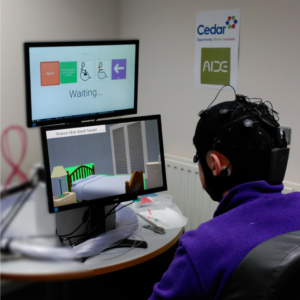
Up to 1 billion people, nearly one in six of the world’s population, suffer from neurological disorders, according to the World Health Organization in 2007, and around 80 million people in the EU, a sixth of its population, have a disability, according to the European Disability Strategy 2010-2020. These statements motivated the scientific community to increase the development of new technologies in the areas of health care, rehabilitation and assistive devices for this group of people.
The AIDE project is one of the latest European projects focusing on the accessibility of persons with disabilities using a wheelchair at home. It consists of an automated wheelchair with an arm exoskeleton that extracts relevant information from the behavior and intentions of the users together with an analysis of the environment. Furthermore, this system is modular and customizable towards disabled people’s needs.
One of the key points of this project was to develop an intelligent Environmental Control Interface (ECI). This is a system that allows a user to operate within their environment and includes an Augmentative and Alternative Communication (AAC), i.e. an adapted communication and entertainment system. The use of this ECI can be personalized according to the capabilities of each user and has a system to predict the user’s intention, the novelty of this research, which facilitates its handling.

We studied the developed ECI and a conventional ECI with two post-stroke patients, two subjects with neurodegenerative disease and four subjects with spinal cord injury.
They performed simulated Activities of Daily Living (ADL) in the same simulated home, using both ECIs at the same time. Then, the results were evaluated in terms of the number of tasks performed, time per task spent and number of steps done to perform each activity.
The main difference between the two ECIs is that the proposed one is able to predict what is the most likely task that user wants to perform by observing the environment around the user and their behavior. This helps them to help navigate through the system. In addition, the users answered a questionnaire in order to assess the work load over the two different ECIs.
The results showed that the proposed ECI is more efficient. The users were able to perform more simulated ADLs while spending less time per task and using fewer steps. However, both systems felt the same as it was the first time that they used this complex system.
We can conclude that the environment analysis and the identification of the user’s behaviors sped up the control of the ECI systems and open a new paradigm in the design of these interfaces.
Comments